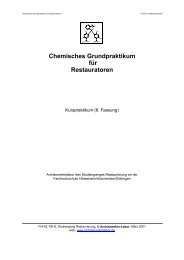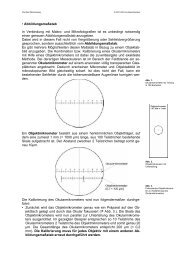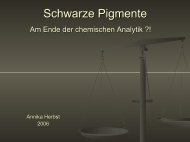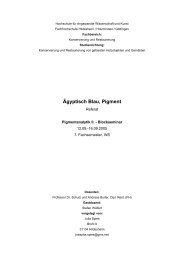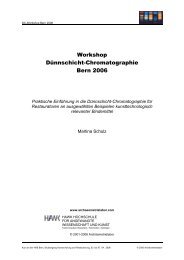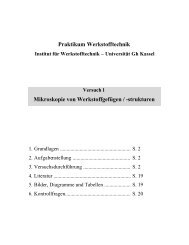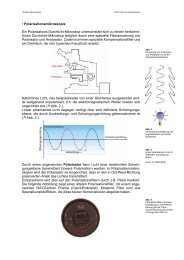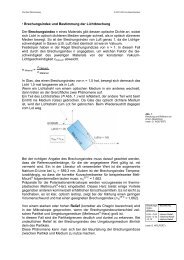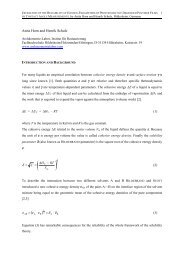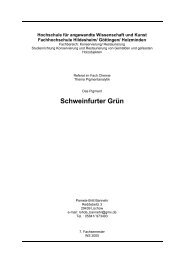Henrik Schulz* and Anita Horn, Archäomertrie-Labor der HAWK ...
Henrik Schulz* and Anita Horn, Archäomertrie-Labor der HAWK ...
Henrik Schulz* and Anita Horn, Archäomertrie-Labor der HAWK ...
Create successful ePaper yourself
Turn your PDF publications into a flip-book with our unique Google optimized e-Paper software.
Manuscript, H. Schulz <strong>and</strong> A. <strong>Horn</strong>, Hildesheim, henrik.schulz@archaeometrielabor.com 13<br />
RESULTS<br />
According to an earlier investigation of wooden surfaces by contact angle measurements [14]<br />
we have always chosen ethylene glycol/water mixtures <strong>and</strong> aqueous calcium chloride<br />
solutions as test liquids. Because of a better reproduction of our results we have measured the<br />
surface tensions γLV resp. the interfacial tensions γLH versus air resp. n-hexane by ourself. The<br />
values are summarized in Table 2:<br />
Table 2: Surface <strong>and</strong> interfacial tensions γLV resp. γLH in [mN/m] of the used test liquids,<br />
aqueous solutions, measured un<strong>der</strong> room condition (25 °C, 60 % RH))<br />
No. # test liquid γLV (versus air) γLH (versus. hexane)<br />
1 CaCl2, 10% 78,1 ±0,40 46,7 ±0,16<br />
2 CaCl2, 5% 73,4 ±0,07 47,5 ±0,05<br />
3 water 70,3 ±0,12 46,6 ±0,07<br />
4 ethylene glycol, 10% 69,2 ±0,07 41,2 ±0,06<br />
5 ethylene glycol, 20% 63,7 ±0,02 35,3 ±0,12<br />
6 ethylene glycol, 30% 59,8 ±0,22 33,1 ±0,02<br />
7 ethylene glycol, 40% 61,6 ±0,29 30,8 ±0,06<br />
8 ethylene glycol, 50% 55,0 ±0,05 27,4 ±0,03<br />
9 ethylene glycol, 60% 51,4 ±0,14 25,5 ±0,05<br />
We notify that our own values verify with those reported by literature [14,15,16] <strong>and</strong> are in a<br />
good agreement.<br />
In strong contrast to the very precise measurements of the surface tensions of liquids by the<br />
pendent drop method which are given above (Table 2) st<strong>and</strong>s the determination of the solid<br />
surface free energy using the contact angle method. Not only the well known but general<br />
effects of the surface roughness <strong>and</strong> especially the chemical heterogeneity of the wooden<br />
surface make it very difficult to measure a reliable <strong>and</strong> representative contact angle of the<br />
wetting <strong>and</strong> spreading test liquid onto the solid surface [17,18]. Unfortunately the measured<br />
contact angles of so-called high energy surfaces like wood exhibit hysteresis <strong>and</strong> cannot be<br />
defined unambiguously by experiment. The results compiled in the tables 3 <strong>and</strong> 4 compare<br />
badly with the conciseness of Table 2. Nevertheless these data should be practicable for the<br />
further discussions. Consi<strong>der</strong>ing the dynamic process of wetting <strong>and</strong> spreading of the test



